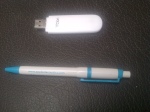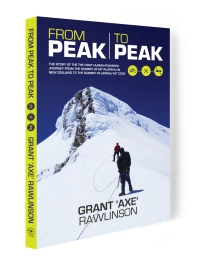Communication and electronics on Everest
I just arrived in Kathmandu!! It was very nice to see friends and family at the airport this morning. I was feeling in a generous spirit so I shouted the coffee at Starbucks. This caught a number of people by surprise as I am quite tightfisted (my great grand parents were from Scotland).
It’s always both an exciting time and a sad time leaving on an expedition. Exciting to think of the upcoming adventure but especially hard to say goodbye to Stephanie and other friends and family. Stephanie will be joining me in ten days time in Kathmandu for 3 nights after I finish my acclimatisation trek on the Annapurna circuit. I leave tomorrow (Monday, 26 March) to walk the Annapurna circuit (independently). I am doing this to kick start the process of acclimatising my body to the higher altitude’s. This involves slowly day by day moving to higher elevations and forcing your body to get used to the reduced oxygen available. This takes time as your body has to produce more red blood cells to transport the limited oxygen more efficiently and also your blood becomes much thicker.
I am looking forward to getting into the mountains and walking by myself for a few days. The Annapurna circuit is known as one of the most beautiful treks in the world. Let’s see if it lives up to its reputation. Not so much looking forward to the headaches, nausea and insomnia which signal the acclimatisation process though.
Well – this blog is dedicated to electronic gadgetry. (I can hear some of you yawning already).
Above is a photo of the gadgets I will be bringing me on Everest 2012. I have numbered each gadget in red and attached below a brief description of each piece of equipment and the reason I chose it.
1. Panasonic CF-19 toughbook laptop computer.(Price around US$5,000)
Reason: Its small light and rugged. Normal laptop computers generally stop working at higher elevations. The moving or spinning hard disk drives in most computers need a tiny cushion of air to spin (you know that whirring sound when you switch on your PC – that’s the sound of the hard disk starting to spin up). At basecamp on Everest the air-pressure is 30% less than that at sea-level. Not only does this affect our bodies, it also screws up computer hard drives. This reduction in air-pressure does not allow the hard disk’s to spin, so they stop working. So computers need to either have solid state hard drives or be specially designed. The Panasonic CF-19 is ruggedised, shock resistant and waterproof and it worked brilliantly last year on Everest. It runs windows XP which is a little dated now, but for the basic work I do on the mountain works fine.
Almost all the software I use is freeware. I am amazed at the powerful programs which you can get free of charge if you look around on the net. I like free stuff because I am quite tightfisted (my great grand parents were from Scotland).
Some of the programs I use most frequently (and are all free) include:
- Google’s PICASA for photo editing and storage
- OPEN Office for wordprocessing e.g writing drafts of blogs. This freeware does most of the basic function that MICROSOFT office does. It allows you to open or save documents in Microsoft word formats also if you need to.
- ANY VIDEO CONVERTOR (AVC). This small application is so handy and very easy to use. It takes any photo or video and allows you to trim it, save it in different formats, and most importantly reduce the resolution. So when I take small video snippets on my Contour Helmet cam even a 60 second file may be 10 – 20MB. Much to large to email back or upload to YOUTUBE from basecamp. AVC will quickly and easily reduce the resolution and file size to something more manageable. Normally for me I try and shrink the video down to 1MB. This of course means you loose significant resolution however its enough to give viewers an idea of what’s going on.
- WordPress. I use wordpress.com to host my blog. This also is completely free. I could pay a small fee per year to get my own domain name e.g. www.Axeoneverest.com, however I am too tight fisted to do this (my great grand parents were from Scotland).
- Microsoft Outlook. This is what I use for email. It is simple to set-up and configure.
- SKYPE – the bandwidth of the China Telecom connection was not fast enough at basecamp in 2011 to get quality voice calls, however I used the text messaging service in SKYPE at times.
- Garmin handheld GPS.(Cost approx S$300)Reason: Its pretty hard to get lost on Everest’s North Ridge route, even in bad weather. Unless you are a complete muppit. I may get lost. My point is I don’t use the GARMIN for storing way-points and navigating much on Everest, however I do use it as a check on the elevations of each camp and to recalibrate my altimeter watch which works off the ambient air-pressure and thus is affected by changes in weather. The GPS elevation I get from the GARMIN are remarkably accurate, I would put +/- 20m as a general estimate of the elevation accuracies.
- NOKIA 2730C Mobile phone.(Cost less than S$100)Reason: This is a very basic NOKIA phone. I use it simply for SMS and voice calls. I like it for its simplicity and its battery life. The battery will last for days and days if I just turn it on and off a few times a day to check messages and SMS. It also uses the same battery as the CONTOUR helmet cam. I have a China Telecom SIM CARD (thank you to Ms Fanny for organising) which I use in the NOKIA. This works at the small villages of Zhangmu, Nyalam and Tingri in Tibet on the drive in and also at Everest Basecamp during the day light hours only(as the mobile repeater at basecamp runs off solar power and shuts down at night).
- Thuruya XT Satellite Phone. (Cost approx US$1000)Reason: Thuruya make a wonderful, light weight, easy to use and easy to top-up the call time sat phone. The call costs are US$0.60c /minute from Tibet to Singapore and NZ, the two countries I call most often. I can also send and receive SMS from this phone. I use this for all communications above Everest basecamp. My general experience is the call quality is good. Thuruya also allows people to send me short text messages from their website for free, which is a great morale booster to receive these when I am on the mountain.
- Blackberry mobile phone. (Cost – approx S$1000)Reason: This is completely unsuited to bringing to remote places, mainly because the battery life sucks. It is a work phone so I can receive work emails (although I have not tested this in Tibet) on it – I am not sure if this is an advantage or a disadvantage! The only other advantage is that it somehow allows users to access facebook in China. Facebook is blocked in China along with YOUTUBE and many other sites. The Blackberry encryption system somehow circumvents this.
- Shortwave Radio(Costs S$25)Reason: I don’t use this much. It can pick up BBC world service in very remote locations such as Everest.
- SONY WALKMAN – ZAPPIN(Cost S$ 150)Reason: This little thing rocks. It stores a few hundred songs, is tiny, no cables and had a long 10+ hour battery life. I currently have downloaded around 150 songs to it.
- Contour HD helmet mounted camera. (Cost S$ 450)
Reason: This little camera I use for video. I don’t take a helmet on Everest, but I have an elastic strap I modified to fit around my head. It’s really simple to use and take’s really nice clear video with only two buttons for operation. Check out my one week training video on the left handside of this post for an example of what the Contour Camera can do. My only gripe is that operating with gloves its easy to accidentally open the battery compartment when trying to turn it on and then watch your battery bounce off 3000m into space below you. It always pisses me off when that happens as I am tightfisted(my great grand parents were from Scotland).
9. Pentax OPTIO RZ10 (Cost S$ 400)
Reason – I had problems with my camera system on Everest last year. I bought a CANON D10 powershot with me which had worked well on previous expeditions. But it stopped working after 4 weeks on Everest, and I did not have a back-up. I chose two camera’s for this trip and was looking for the following functionality.
- Both camera to be small compact and lightweight
- Large button operation – easy to operate with gloves on. This was the hardest thing to find. There are literally hundreds of great little camera’s out there but when you try and find ones you can operate wearing gloves or mittens then it seems to cut out 98% of them. There is no point taking a beautiful big camera with you that a: is too heavy, b: you cant operate with gloves on and c: it freezes up.
- Cold weather operation. Very important on Everest especially where temperatures get to minus 40 or 50 degrees C. You have to keep the camera inside your jacket close to your body to stop it freezing then take it out quickly and take a photo before it freezes. For this reason the camera must be small enough to fit comfortably inside your jacket.
- Batteries and memory cards. I wanted both camera’s to share the same battery and memory cards to simplify things so I only needed to bring one charger and download cable etc..
The Pentax OPTIO RZ10 has nice large buttons, 14 Mega Pixels, 10x zoom. It has HD video recording but I don’t find the video quality near as good as from my Contour helmet cam.
- Pentax OPTIO WG-1 ruggedised digital camera.(Cost approx S$ 400)Reason: This is basically a ruggedised version of the camera above, same basic functionality however it has slightly lower resolution and zoom. It makes up for this my being temperature rated to minus 10 degrees, water proof to 33 feet and shock proof. It also has nice large buttons and one feature I particularly like and am continually amused by, but is really quite useless is that it makes a squeaking sound like a mouse being strangled every time I take a photo.
- Head torches.Reason: Two head torches, one main one (the Petzl) and a back-up (black diamond). The Petzl is a beautiful reliable, powerful beam head torch. It’s downside is its size and when I wear large goggles and an oxygen mask it wont fit properly on my head as my face is quite small. The back-up Black Diamond is the biggest piece of shit, not the most reliable head torch I have ever used. I don’t recommend this model. However I own it now and am too tight fisted (my great grand parents were from Scotland) to throw it away.
- Charging cables.Reason: I have two charging systems for every piece of kit I have. AC 220V chargers for use in Kathmandu and towns/villages where there is mains power supply. DC 12V chargers with cigarette lighter adapters which I use as basecamp and on the mountain where we rely completely on solar power.
- 16GB USB memory sticks and 8GB SD flash cardsReason: for backing up data and using in video and camera.
- Electrical power socket adapterReason: fits any country in the worlds electrical socket.
- AC charger for camera batteriesReason: to charge camera batteries in towns and villages where there is mains supply power
- Portable battery charger to recharge SONY WALKMAN.Reason: This runs off 2 x disposable double A batteries and allows me to recharge my SONY WALKMAN wherever I am. It also connects to my blackberry and will run the blackberry but will not charge the battery – must be a voltage issue.
- Rechargeable batteries for camera, Nokia phone and Contour HD video camera.Reason: The Contour video and the NOKIA share the same battery. The two Pentax camera’s share the same battery. This is cool. The more devices you can get which share the same batteries the better. Means you have higher redundancy and less chargers and cables to bring along.
- DC cable for camera battery chargerReason: Charging camera batteries off solar panels on the mountain
- DC charger for Panasonic toughbookReason: Charging Panasonic toughbook computer off solar panels on the mountain
I use a USB modem with a China Telecom SIMCARD inside it to upload most of my blog posts.  This connects wirelessly to the China Mobile cellphone towers along the drive into basecamp and even at basecamp itself. The only downside to this is that everything you send out is monitored. I did not believe this until last years expedition. A certain trekker in a group sharing our basecamp, uploaded some ‘sensitive’ remarks about her view point of a particular country. The next morning soldiers appeared at our tent and took her away for a good few hours talking to. She came back visibly upset and did not talk further about the incident.
This connects wirelessly to the China Mobile cellphone towers along the drive into basecamp and even at basecamp itself. The only downside to this is that everything you send out is monitored. I did not believe this until last years expedition. A certain trekker in a group sharing our basecamp, uploaded some ‘sensitive’ remarks about her view point of a particular country. The next morning soldiers appeared at our tent and took her away for a good few hours talking to. She came back visibly upset and did not talk further about the incident.
If I want to communicate from the 5 camps above basecamp, where there is no more China Mobile coverage – I have four options:
- Call or SMS David Lim in Singapore using my satellite phone to write a post on my behalf
- Connect to internet using a BGAN (satellite modem) which is quite expensive and they charge per MB of upload and download.
- Call my website wordpress.com and leave a voice message update. This is a very cool feature where I have a number I call and leave a voice message. After I hang up it automatically posts my voice message to my blog. Its also free (apart from the cost of the call) which I like as I am quite tightfisted (my great grand parents were from Scotland).
- Send a smoke signal
That’s all for now, sorry for mentioning so many times in this post that my great grandparents were from Scotland. I am actually very proud to have Scottish ancestry. My beard even turns ginger when it gets longer and I like to think I look a little like those rugged Scottish highlander types you see in the movies who hide in the hills then kill the english soldiers when they turn up in their villages for a cup of tea and to collect the taxes. I can’t remember the movies name unfortunately. What I can remember is that I did not watch it at the movies but I downloaded it for free off the internet as I am quite tightfisted (my great grand parents were from Scotland).
Love
Axe
Posted on March 25, 2012, in Equipment and Gear, Everest 2012. Bookmark the permalink. 13 Comments.







This is very Interesting! Wish the camera works well this time so we get to see more live actions from you!
LikeLike
Ruggedised…… Are we claiming this as English. And lay off the Scots, not all of us are cheap – well maybe we are!
Enjoy Annapurna
Nicola
LikeLike
Nic!!!!! Are you Scottish? You kept that very quiet!
LikeLike
Your lack of prowess on a pint shows that you have (thankfully) been removed from Gods Country for quite some time. very best of luck. Barclay
LikeLike
nothing wrong with a bit of Ginga mate 🙂 Braveheart that’s the movies name….and they did a lot more than drinking tea and taking tax’s!!
Good luck once again and I look forward that boat cruise when yo uare back.
LikeLike
Ah braveheart that’s it!! Thanks for the reminder scotty and sure will look forward to catching up with you when I get back!
LikeLike
GOLD!
LikeLike
All d way man n Njoy…best of luck!
LikeLike
Are you sure you’re not a Leprachaun?
LikeLike
Are you planning to run your Contour camera all the way to the top and back when it is light enough to do so? I guess there will be storage and power constraints but it would be great for us armchair climbers to be able to watch a whole trek to the top from a head camera.
LikeLike
Hello Mike, whether I take video or not will depend on how cold and windy it is and how I am feeling. I sure hope to take some short snippets to show you.
LikeLike
Thanks Axe, I really would appreciate that. Good luck with the acclimatisation over the next few days. We are really enjoying reading your blog and following your progress.
LikeLike
Pingback: Everest 2012 Weekend Update March 25 » The Blog on alanarnette.com